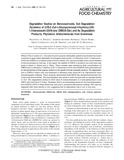Mostrar el registro sencillo del ítem
Degradation Studies on Benzoxazinoids. Soil Degradation Dynamics of (2 R)-2-O-B-D- Glucopyranosyl-4-hydroxy-(2 H)-1,4-benzoxazin-3(4 H)-one (DIBOA-Glc) and Its Degradation Products, Phytotoxic Allelochemicals from Gramineae.
| dc.rights.license | http://creativecommons.org/licenses/by-nc-sa/3.0/ve/ | |
| dc.contributor.author | Oliveros Bastidas, Alberto | es_VE |
| dc.contributor.author | Macías, Francisco A. | es_VE |
| dc.contributor.author | Marín, David | es_VE |
| dc.contributor.author | Castellano, Diego | es_VE |
| dc.contributor.author | Simonet, Ana M. | es_VE |
| dc.contributor.author | Molinillo G., José | es_VE |
| dc.date | 2005-07-27 | es_VE |
| dc.date.accessioned | 2005-07-27T09:00:00Z | |
| dc.date.available | 2005-07-27T09:00:00Z | |
| dc.date.created | 2005-01-01 | es_VE |
| dc.date.issued | 2005-07-27T09:00:00Z | es_VE |
| dc.identifier.other | T016300002003/0 | es_VE |
| dc.identifier.uri | http://www.saber.ula.ve/handle/123456789/16811 | |
| dc.description.abstract | Degradation Studies on Benzoxazinoids. Soil Degradation Dynamics of (2 R)-2-O-B-D-Glucopyranosy l-4-hydroxy-(2 H)-1,4-benzoxazin-3(4 H)-one (DIBOA-Glc) and Its Degradation Products, Phytotoxic Allelochemicals from Gramineae (Macías, Francisco A.; Oliveros, Alberto; Marín, David; Castellano, Diego; Simonet, Ana M. and Molinillo G., José M.) Abstract Wheat (Triticum aestivumL.) has been found to possess allelopathic potential and studies have been conduced to apply wheat allelopathy for biological weed control. 2,4-Dihydroxy-(2 H)-1,4-benzoxazin-3(4 H)-one (DIBOA) is a common product found in wheat, corn, and rye exudates and it can be released to the environment by that way. In this report, the stability of DIBOA is studied in two soils from crop lands of wheat cv. Astron and cv. Ritmo. These varieties were selected by their concentrations of DIBOA and 2,4-dihydroxy-7-methoxy-(2 H)-1,4-benzoxazin-3(4 H)-one (DIMBOA) from aerial parts and by the bioactivities of their aqueous extracts in the growth of wheat coleoptiles sections. The degradation rate of DIBOA in these soils was measured in laboratory tests during 90 h by high-pressure liquid chromatography methods. These analyses demonstrate that DIBOA was transformed primarily into 2-benzoxazolinone (BOA). This transformation was similar in both soil types with an average half-life of 43 h. The degradation studies for BOA show its biotransformation to 2-aminophenoxazin-3-one (APO) with a half-life of 2.5 days. Therefore, BOA is an intermediate product in the biotransformation from DIBOA to APO in these wheat crop soils and is consistent with previous findings. APO was not degraded after three months in soil, suggesting that its degradation rate in soil is very slow. Published on: Journal of Agricultural and Food Chemistry 2005, 53, 554-561. | es_VE |
| dc.format.extent | 165172 | es_VE |
| dc.language.iso | es | es_VE |
| dc.publisher | SABER ULA | es_VE |
| dc.rights | info:eu-repo/semantics/openAccess | |
| dc.subject | Grupo de Química Ecológica | es_VE |
| dc.title | Degradation Studies on Benzoxazinoids. Soil Degradation Dynamics of (2 R)-2-O-B-D- Glucopyranosyl-4-hydroxy-(2 H)-1,4-benzoxazin-3(4 H)-one (DIBOA-Glc) and Its Degradation Products, Phytotoxic Allelochemicals from Gramineae. | es_VE |
| dc.type | info:eu-repo/semantics/article | |
| dc.description.email | aloliver@ula.ve | es_VE |
| dc.description.email | famacias@uca.es | es_VE |
| dc.description.tiponivel | Nivel monográfico | es_VE |
| dc.subject.departamento | Departamento de Química | es_VE |
| dc.subject.escuela | Escuela de Ciencias. | es_VE |
| dc.subject.facultad | Facultad de Ciencias. | es_VE |
| dc.subject.keywords | Benzoxazinoids | es_VE |
| dc.subject.keywords | DIBOA-Glc | es_VE |
| dc.subject.keywords | DIBOA | es_VE |
| dc.subject.keywords | Biodegradations | es_VE |
| dc.subject.keywords | Soil | es_VE |
| dc.subject.keywords | Triticum aestivum | es_VE |
| dc.subject.keywords | Bioactivity | es_VE |
| dc.subject.tipo | Artículos | es_VE |
Ficheros en el ítem
Este ítem aparece en la(s) siguiente(s) colección(ones)
-
Articulos, Pre-prints (Facultad de Ciencias)
-
Articulos, Pre-prints (Grupo de Química Ecológica)
Articulos, Pre-prints del Grupo de Química Ecológica


